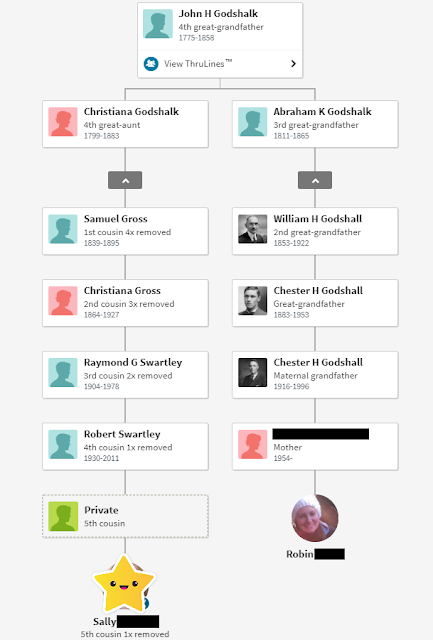Naturally, this opens the system and connections up to a lot of room for error. We all know how inaccurate some trees out there can be, how those errors can get copied by the dozens, and I'm not going to pretend that this isn't an issue. Anytime you're working with trees, you absolutely must verify the information yourself before you accept it as fact.
But that doesn't mean ThruLines can't be useful. I've been working with them for a few weeks now, and I have found that the majority of them can be verified with a little work. Some of them I haven't been able to verify at all and remain unknowns, and others I have actually proven wrong, but the amount of them which I've been able to confirm far exceeds the old Shared Ancestors Hints which were limited to looking at your tree and your match's tree only. ThruLines is finding legit shared ancestors that neither the system or myself doing the work manually could have ever found before. Take the following example.
As you can see, Sally has a family tree with only 3 people in it and on top of that, it's a private tree. In the past, this would be a complete dead end. Unless I contacted her and she responded to tell me more about her tree or at least give me access (which I likely wouldn't do for every match at this distance), I would have completely written off this match in the past.
But now, ThruLines has found a common ancestor! Just by adding those mere 3 people to her tree and making her tree searchable even if it's private, Sally has allowed ThruLines to find a connection between us. Of course, I first have to make sure ThruLines isn't leading me astray, so let's look at the connection.
Part of what you're seeing here is the benefit of researching as far down the descendant lines of your ancestor's siblings as possible. When I first looked at our ThruLines relationship, I had only researched down to Samuel Gross, and Sally's tree only went back to her grandparent. The two generations in between were being filled in by ThruLines finding them in other trees. Of course, to verify the relationship, I had to do my own research and fill in the missing generations, but this was much easier since I'd already gotten a head start. I researched all the way down to Sally's grandfather, Robert. Since her tree was private, Robert was originally shown as private, but you can actually click on deceased people in private trees and get basic details like their name and birth, just like you would from clicking on results of a private tree in the search engine results (see below). If they are still living, you get nothing, as it should be - living people's privacy is always totally protected (also see below).
ThruLines isn't perfect, of course. It's only as reliable as the trees it's using, and I have found errors in the trees it uses on occasion. Additionally, the system itself is not infallible and I have come across the occasional case where ThruLines is assuming two different people are the same person. In those cases, the error is with the system, not the trees it's using.
But we are genealogists - fact checking and verifying data is what we do. So let's do it! You might find ThruLines just as beneficial as I have so far. It has found common ancestors with people that the old system wouldn't have, and with people I never found have by searching manually on my own.





Well done, I agree with you. I've been doing essentially what you are doing since we got ThruLines. I have found some errors in other trees (and in the Ancestry Big Tree which I still think they are using to find common ancestors), but like you said "we are genealogists ... and that is what we do."
ReplyDelete